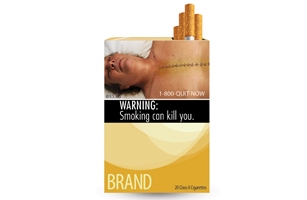As with so many other things, John Lennon may have said it best: “Curse Sir Walter Raleigh, he was such a stupid git.” Of course, that lyric, from the Beatles song “So Tired,” comes after he says, “I’m so tired, I’m feeling so upset…Although I’m so tired, I’ll have another cigarette.”
As much as Lennon might have cursed Raleigh, the Englishman who brought tobacco smoking from the New World to Europe, he still wanted another smoke. And he probably looked pretty cool dragging from it, too, conveying desperation as he inhaled deeply and world-weary satisfaction as he exhaled a cloud of carcinogen-filled smoke.
This morning, the Food and Drug Administration unveiled a series of often graphic images that will be plastered on cigarette packages, above the brand and the outside of the box. They include a man exhaling smoke through a tracheotomy hole in his neck and a mouth ravaged by oral cancer.. Tobacco companies R. J. Reynolds, Lorillard and Commonwealth Brands told the FDA that the warnings are “intended to elicit loathing, disgust, and repulsion” despite the fact that their products are legal.
Of course that’s what the new warnings are supposed to do, and they have to if they’re going to combat years of built up cultural encouragement about smoking. Smoking — an addictive, deadly behavior that lines the coffers of companies that do little if any good for the world — somehow persists as a pose of rebellion. That persisted from James Dean to Joe Strummer to Kurt Cobain.
In 1965, when the Surgeon General’s first report on smoking was issued, 42% of Americans smoked. Warnings and public education cut that in half, but the percentage of Americans who smoke has stalled at 21%, meaning 47 million Americans smoke cigarettes. Of those who don’t quit, half will die of smoking related illnesses including lung cancer and heart disease. One in five deaths is caused by smoking, including a third of cancer deaths.
The realization that a common behavior that had actually been touted by its manufacturers as doctor-recommended was killing people in large numbers represented a turning point for medicine. At around the same time, the FDA’s power to regulate drugs was being strengthened to include not just rudimentary proof of safety, but also proof of efficacy. It’s shocking to think it, but randomized controlled clinical trials, the gold standard for medical research in which patients are assigned at random to achieve one of two treatments, were still brand new. The first, of streptomycin in tuberculosis, was published in 1948.
Traditionally, scientists what was causing a clear and undeniable case of illness — like cholera. The classic case study of epidemiology, chronicled in Steven Johnson’s book The Ghost Map, was John Snow’s realization that a cholera outbreak was caused by contaminated water. But in this new world, collecting data became a way to figure out if people were sick. To this we owe a the creation of powerful cholesterol and blood-pressure drugs that combat heart disease, and also the dawning realization that some medicines, like Vioxx, Avandia, and Baycol carried their own risks.
But this revolution has had its limits. Drugs to prevent smoking like Zyban and Chantix, for instance, have been shown by randomized controlled clinical trials to not be that effective. With computing power increasing at an amazing pace and more and more data moving to the cloud, it should be easier to pick up these otherwise invisible trends and improve public health. Except that we don’t have standardized electronic health records, and don’t seem sure of a way to accumulate or manage them. Why would we? 
.png)

 Two months after being arrested for possession of cocaine, oil heir Brandon Davis has pleaded guilty to the charge in a Los Angeles court.
Two months after being arrested for possession of cocaine, oil heir Brandon Davis has pleaded guilty to the charge in a Los Angeles court.







0 comments: